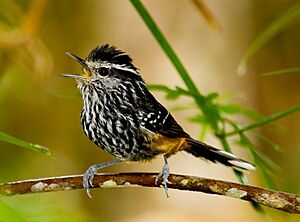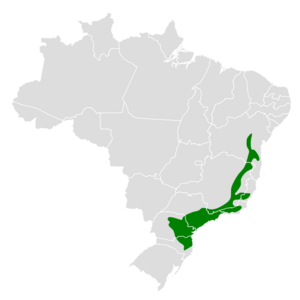Ochre-rumped antbird facts for kids
The ochre-rumped antbird (Drymophila ochropyga) is a small bird that lives only in Brazil. It's part of a group of birds called "typical antbirds." These birds are known for living in thick forests.
Quick facts for kids Ochre-rumped antbird |
|
|---|---|
 |
|
| Conservation status | |
| Scientific classification | |
| Genus: |
Drymophila
|
| Species: |
ochropyga
|
 |
|
Contents
About This Bird
The ochre-rumped antbird is very closely related to another bird called the rufous-tailed antbird. These two birds are like "sister species." This means they share a recent common ancestor. Each of these birds is the only one of its kind in its specific group.
What Does It Look Like?
The ochre-rumped antbird is about 12.5 to 13.5 cm (4.9 to 5.3 in) long. That's about the size of a small sparrow.
Male Antbird Appearance
Male antbirds have a black cap on their head. They have a long white stripe above their eye, called a supercilium. A black band goes through their eye. Their cheeks are white with black speckles.
Their back is gray with some black and white feathers. They have a white patch between their shoulders. Their lower back, called the rump, is a light reddish-brown color.
Their wings are dark with thin buff edges on the flight feathers. They also have wide white tips on the wing coverts. Their throat and chest are white. They have black streaks, which are heavier on their chest. Their sides and under-tail area are plain reddish-brown.
Female Antbird Appearance
Female antbirds look a bit different. Their cap has buff streaks. Their back is olive-gray. Their underparts are duller and more buffy. They also have fewer streaks than the males.
Where Does It Live?
The ochre-rumped antbird lives in the Atlantic Forest mountains of southeastern Brazil. You can find it from central and southeastern Bahia south through eastern Minas Gerais and Espírito Santo. It also lives in eastern São Paulo, eastern Paraná, and eastern Santa Catarina.
Its Home in the Forest
This bird mostly lives in the lower parts of bamboo and vine thickets. These thickets are found in mountain evergreen forests. Sometimes, it also lives in lowland evergreen forests. It can be found at elevations between 300 and 1,950 m (1,000 and 6,400 ft).
How Does It Behave?
Movement and Travel
Scientists believe the ochre-rumped antbird stays in its home area all year. However, it might move to new places if the bamboo stands it lives in start to die off.
What It Eats and How It Finds Food
The ochre-rumped antbird mainly eats many different kinds of arthropods. These are small creatures like insects and spiders. It usually hunts alone, in pairs, or in family groups. It typically forages within about 3 m (10 ft) of the ground. It rarely goes higher than that.
Sometimes, it joins other groups of birds that are feeding together. These are called mixed-species feeding flocks. It is not known to follow swarms of army ants. It looks for food in bamboo stands and nearby vine tangles. It hops actively through these areas, flicking its tail. It mostly picks prey from dead leaves. It often reaches out from a perch to grab its food.
Reproduction and Life Cycle
We know that the ochre-rumped antbird lays white eggs. These eggs have irregular reddish-brown speckles, blotches, and lines. Beyond this, not much else is known about how these birds reproduce.
Its Calls and Songs
The song of the ochre-rumped antbird is a "2-note 'tí-zzzzèh'." The first note is very high and sharp. The second note is long and sounds a bit hoarse. Its most common call is "a series of 3–5 evenly spaced, piercing, sharp notes."
Conservation Status
The IUCN (International Union for Conservation of Nature) looks at how safe different animal species are. For the ochre-rumped antbird, they first said it was "Near Threatened" in 1988. Then, in 1994, they didn't know enough about it. In 2004, it was "Near Threatened" again. But since 2023, it has been listed as "Least Concern." This means it is not currently in danger of disappearing.
We don't know exactly how many of these birds there are. However, their numbers are thought to be going down. The main reasons for this are cities growing, new factories, farms expanding, and more roads being built. Even though its population is decreasing, it is considered fairly common in some local areas. It also lives in several protected areas.
This bird needs specific places to live, especially bamboo. Sometimes, large areas of bamboo can die off. This can cause the number of these birds, and other birds that rely on bamboo, to go up and down.


